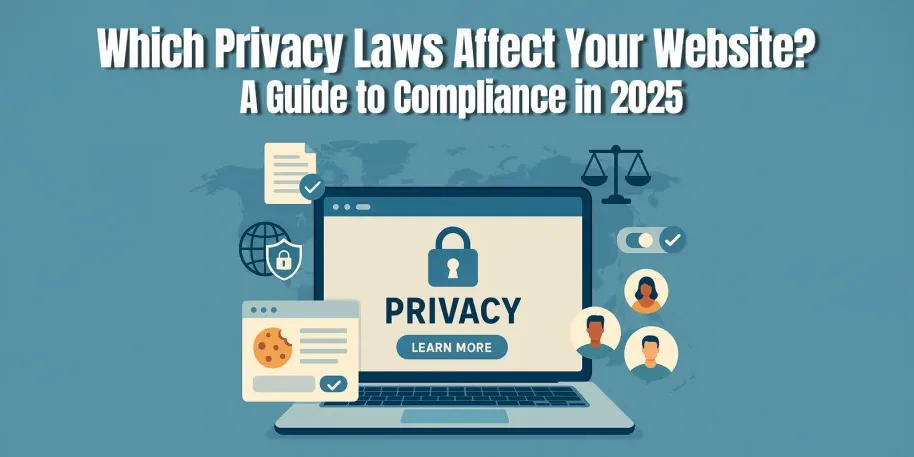

Which Privacy Laws Affect Your Website? A Guide to Compliance in 2025
Posted March 11, 2025 by Kevin Chern
“Privacy is not something that I’m merely entitled to, it’s an absolute prerequisite.” – Marlon Brando
Back in 2023, a rapidly growing online retail business based in Chicago received a surprising notification of non-compliance with GDPR, Europe’s stringent data privacy law. Despite having minimal European traffic, the retailer faced fines totaling $500,000 due to improper handling and lack of transparency regarding customer data. This incident didn’t just dent their finances; it severely impacted customer trust and growth potential.
Today, as a business owner, ensuring your website compliance with global privacy laws isn’t just about dodging fines; it’s about maintaining trust, enhancing your brand reputation, and fueling sustainable growth. Navigating these legal waters can feel like crossing a minefield blindfolded but fear not, I’m here to be your guide.
Why Website Compliance is Crucial in 2025
Imagine your website as your virtual storefront open to the entire globe. Just as physical stores must comply with local laws, your digital presence must adhere to an increasingly complex web of international regulations.
According to Gartner, by 2025, more than 80% of global enterprises will face privacy compliance challenges across multiple jurisdictions. Ignoring website compliance isn’t an option; it’s akin to driving without a seatbelt risky and potentially costly.
Decoding Global Privacy Regulations
Let’s break down major global privacy regulations every business owner needs to know:
1. General Data Protection Regulation (GDPR)
GDPR, effective since 2018, fundamentally changed data privacy handling. It affects any business dealing with European residents, irrespective of location. Penalties for non-compliance can reach €20 million or 4% of annual global turnover, whichever is higher.
2. California Consumer Privacy Act (CCPA)
Similar to GDPR, the CCPA grants California residents significant rights over their personal data. Fines for non-compliance can reach $7,500 per violation. (Note: California isn’t the only state with privacy laws, but it’s a widely recognized one.)
3. Virginia Consumer Data Protection Act (VCDPA)
Effective in 2023, the VCDPA grants Virginia residents control over their personal data, including rights to access, delete, and correct data. Fines for violations can go up to $7,500 per violation, similar to California’s CCPA. Companies must also conduct risk assessments related to their processing of personal data.
4. Colorado Privacy Act (CPA)
The Colorado Privacy Act, effective in 2023, provides residents with rights to access, delete, and opt out of the sale of personal data. The CPA emphasizes consumer control, imposing penalties for non-compliance. Fines can be up to $20,000 per violation, with businesses required to conduct data protection impact assessments under certain conditions.
5. New York Privacy Act (NYPA)
New York is considering the NYPA, a proposed privacy law that will strengthen protections for personal data, granting rights to access, rectify, and delete data. The NYPA aims to regulate data brokers and may lead to significant penalties for businesses that fail to comply. Though not fully enacted yet, businesses should prepare for its potential impact.
6. Utah Consumer Privacy Act (UCPA)
Enacted in 2023, Utah’s privacy law provides a balance between consumer rights and business responsibilities. It requires businesses to give consumers the ability to access, delete, and opt out of data sales. Non-compliance can lead to penalties of up to $7,500 per violation. Utah’s law is often seen as one of the more business-friendly privacy laws in the U.S.
7. Nevada Privacy Law
Nevada’s privacy law, which focuses on the sale of personal data, requires businesses to offer consumers the option to opt-out of the sale of their personal information. The law includes penalties for non-compliance, though they are typically lower than those in California or Virginia.
Steps to Ensure Website Compliance
Here’s how to transform your website from compliance chaos into a smoothly running machine:
- Implement Transparent Privacy Policies
A clear, accessible, and thorough privacy policy is non-negotiable. According to a Pew Research study, 79% of users expect businesses to clearly state how their data is used.
- Clearly state what data is collected and why.
- Detail how data is stored, secured, and shared.
- Provide instructions on how users can access or delete their information.
2. Secure Explicit User Consent
Consent is your digital handshake. CCPA and similar laws require explicit, informed consent. Tools like cookie banners, explicit consent forms, and clear opt-out mechanisms help you achieve compliance effortlessly.
3. Adopt Privacy by Design (PbD)
Think of PbD as building privacy into your website’s DNA. It ensures compliance from inception rather than retroactively patching issues. Companies adopting PbD reduce compliance costs by approximately 30% according to Forrester.
4. Regular Compliance Audits
Schedule regular audits to identify and rectify vulnerabilities proactively. Deloitte notes businesses conducting biannual privacy audits reduce non-compliance risk by 40%.
5. Leveraging Technology for Compliance
Modern compliance doesn’t have to be manual or cumbersome. Employ robust compliance software solutions like OneTrust, TrustArc, or Cookiebot to automate consent management and data protection processes. Gartner forecasts the privacy management software market will reach $4 billion by 2026, highlighting the growing importance of tech in compliance.
6. Understanding Cross-Border Data Transfers
Cross-border data transfers often feel like navigating international airspace complex and filled with rules. GDPR and similar laws require adequate safeguards (Standard Contractual Clauses or Binding Corporate Rules). Ignoring these can halt international business operations entirely.
7. Handling Data Breaches Effectively
Data breaches aren’t hypothetical they’re increasingly common. IBM reports the average global cost of a data breach in 2024 was $4.35 million. Establish clear breach response protocols, ensuring rapid containment, notification to authorities, and transparent communication with customers.
8. Employee Training and Compliance Culture
Your employees are frontline defenders of your compliance strategy. Regular training ensures they understand and adhere to privacy protocols. Companies investing in ongoing compliance training see a 28% improvement in compliance effectiveness (PwC).
9. Responding to Compliance Violations
When violations occur, prompt, transparent action mitigates fallout. Cooperating with regulatory bodies can significantly reduce penalties and reputational damage. Transparency, accountability, and corrective measures reassure customers and regulators alike.
10. Turning Compliance into a Competitive Advantage
Compliance isn’t merely a regulatory obligation, it’s a powerful brand differentiator. 87% of consumers prefer doing business with transparent companies (Accenture). Highlighting compliance efforts builds customer trust, loyalty, and market reputation.
Compliance Myths Debunked
Let’s address common misconceptions:
- Myth: Small businesses aren’t targets. (Reality: Small businesses represent 43% of cyber-attacks – Verizon, 2023.)
- Myth: Compliance is costly. (Reality: Non-compliance penalties are substantially higher than compliance costs.)
- Myth: Only tech companies need compliance. (Reality: Any business handling data must comply.)
Final Thoughts
Website compliance isn’t just legal housekeeping it’s an essential business strategy. Compliance protects your brand, maintains customer trust, and enables global scalability.
Have you positioned your business effectively to thrive in the global privacy landscape, or are you vulnerable to unseen compliance risks?
If you’re unsure whether your data practices align with evolving global laws, our team at Sanguine can help. Schedule a consultation today.

Kevin Chern – CEO – Sanguine Strategic Advisors
After 30 years of building businesses while navigating some of the most complex paths to success, Kevin Chern founded Sanguine Strategic Advisors to lend his insight and experience to other serial entrepreneurs, small business owners and folks in need of a roll-up-your-sleeves innovator, deal maker and doer.
Tags:




